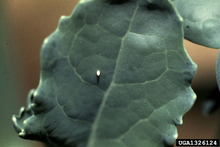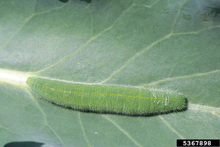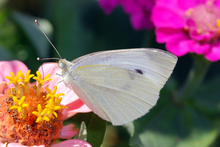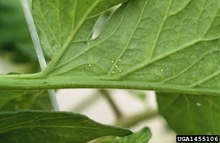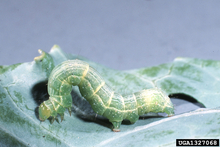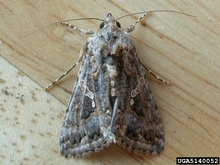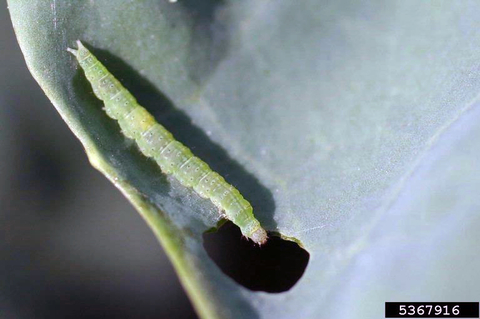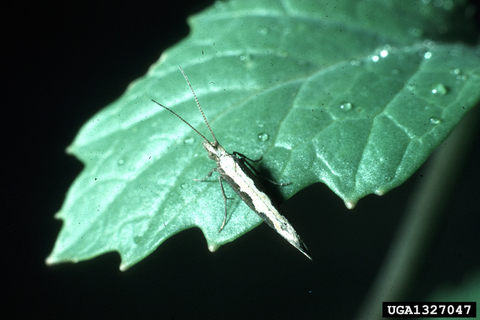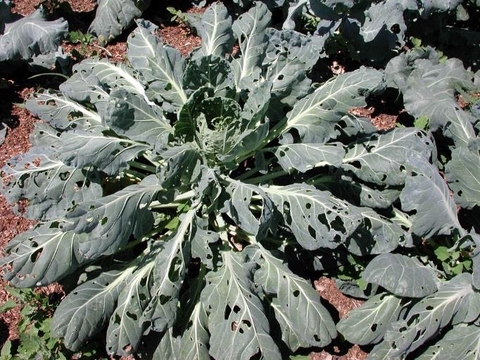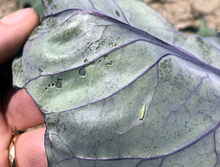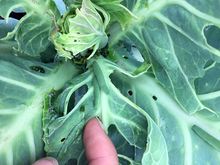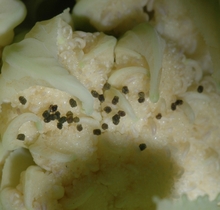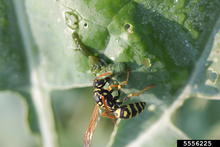Quick facts
- Cole crops include cabbage, cauliflower, broccoli, kale, rutabaga, radish, turnip and collard.
- The most common caterpillar pests of cole crops are imported cabbageworm, cabbage looper and diamondback moth.
- The imported cabbageworm is the most common caterpillar in gardens.
- All caterpillars feed between the large veins and midribs of cole crops.
- Older, larger caterpillars cause the most feeding damage.
- Treat caterpillars when they are still small and before they cause too much feeding damage.
How to identify caterpillars
Imported cabbageworm (Pieris rapae):
Adult butterflies are commonly seen flying around plants during the day.
- Adults are white butterflies with black spots on the forewings.
- Eggs are yellow and oblong, and are on both upper and lower sides of leaves.
- Caterpillars can grow up to 1 inch in length and are velvety green with faint yellow stripes running lengthwise down the back and sides.
- They move sluggishly when prodded.
Cabbage looper (Trichoplusia ni):
Adults are nocturnal moths with a 1½-inch wing span.
- Adult moths have mottled grayish brown wings.
- A small silvery white figure 8 is in the middle of each of the front wings.
- Eggs are creamy white, aspirin-shaped, and about the size of a pin head.
- Adults lay eggs on the undersides of the lower leaves.
- Caterpillars are pale green with narrow white lines running down each side.
- Full grown caterpillars are about 1½ inches long.
Cabbage looper caterpillars have no legs in their middle sections and make a characteristic looping motion as they move across vegetation.
Diamondback moths (Plutella xylostella):
- Adult moths are nocturnal flyers.
- Moths are light brown and slender.
- The folded wings show a pattern of three white diamonds.
- Eggs are laid near leaf veins on the leaf and are creamy-white and tiny.
- Caterpillars are light green, tapered at both ends, and grow up to 1/3 inch long, much smaller than imported cabbageworms and cabbage loopers.
- They wiggle vigorously when touched.
Biology of caterpillars
All three species have similar life cycles.
- Eggs hatch into caterpillars and then damage plants.
- After feeding for weeks on cole crops, the larvae change into pupae in protected areas on the plants.
- Then they emerge as adults.
In the upper Midwest, they live through the winter in green pupal cases.
- Adults begin to appear in gardens in mid-May.
- They are a problem through the rest of the growing season.
- 3 to 5 overlapping generations a year.
They do not survive the winter in the upper Midwest.
- Moths migrate from the south into Minnesota from early July to late August.
- 1 to 3 generations a year during the growing season depending on their arrival time and late summer temperatures.
In the upper Midwest, they live through the winter as adults in protected locations.
- Moths begin to appear in mid-May.
- Can be pests through the remainder of the growing season.
- Generally 3 to 5 generations a year.
Damage
- Cole crops can tolerate some feeding damage.
- Young seedlings and transplants are most susceptible to injury.
- Severe defoliation of young seedlings and transplants can cause distorted growth or death.
- Extensive feeding can also prevent the head formation of cabbage, cauliflower and broccoli.
- Older plants can tolerate some defoliation with little effect on yield. Do not allow defoliation to exceed 30 percent of leaves.
The caterpillars of all three species feed between the large veins and midribs of cole crops.
Diamondback larva feeding
- Starts feeding inside the leaves and then moves to the outside of the leaves.
- Eats all the leaf tissue except the upper layer, giving a windowpane look.
Imported cabbageworm and cabbage looper feeding
- Young caterpillars produce small holes in leaves that do not break through to the upper leaf surface.
- Larger caterpillars chew large, ragged holes in the leaves leaving the large veins intact.
- In cabbage, broccoli, or cauliflower, larger caterpillars crawl toward the center and leave large amounts of frass (fecal matter).
Managing caterpillars in cole crops in home gardens
Check for caterpillars and their feeding damage on both sides of leaves on cole crops. Check at least once a week right after planting and more often as the season progresses.
Make gardens less welcoming to pests
- Destroy crop residue immediately to eliminate protected sites that imported cabbageworms may use to survive the winter.
- Remove weeds from the Brassicaceae family like wild mustard, peppergrass and shepherd's purse, as they are alternate hosts for these pests.
Handpick and drop the caterpillars into a pail of soapy water to kill them.
Floating row covers made up of lightweight all-purpose garden fabric keep the adult moths from laying eggs on plants.
- Fit the row covers directly over garden plants or over metal hoops/wooden frame to cover the cole crops at seeding or transplanting.
- Remove row covers after harvesting the crop
Natural enemies can reduce caterpillar numbers.
Cabbage looper, imported cabbageworm, and diamondback moth have both predators and parasitoids that help keep caterpillar populations low.
Predators include paper wasps and lady beetles. Parasitoid wasps and flies also lay eggs in caterpillars.
The best time to treat caterpillars is while they are still small and before they cause too much feeding damage. Pesticides are less effective in killing larger caterpillars.
There are several low-risk pesticide options that have less impact on natural enemies and pollinators such as bees and flies.
- Pyrethrins need to be sprayed directly on the caterpillars to be effective
- Neem is a plant-based pesticide that does not kill insects, but it causes them to stop feeding and they eventually die.
- Spinosad is derived from a naturally occurring soil-dwelling microorganism, that is effective against chewing insects like caterpillars.
- Bacillius thuringiensis (Bt) is a bacterium that occurs naturally in the soil. Caterpillars must eat it to be effective. Get good coverage on the leaves when spraying.
Conventional, or broad-spectrum pesticides, are longer lasting but they can kill natural enemies. Common examples of broad spectrum pesticides include permethrin, beta-cyfluthrin, and lambda-cyhalothrin.
CAUTION: Mention of a pesticide or use of a pesticide label is for educational purposes only. Always follow the pesticide label directions attached to the pesticide container you are using. Be sure that the plant you wish to treat is listed on the label of the pesticide you intend to use. And observe the number of days between pesticide application and when you can harvest your crop. Remember, the label is the law.
Managing caterpillars on cole crops on farms
- Scouting is the best way to determine what local caterpillar pest pressure is.
- Be sure to note which species you see feeding.
- Removing alternative food sources and overwintering sites can help reduce local pest populations.
- Removal of brassica weeds such as field mustard removes a food source and egg-laying site.
- Crop residue removal or destruction reduces feeding and overwintering sites.
- There are native parasitoids of cole crop caterpillars, including species of flies and wasps. Their levels vary by location and year.
- There are also predators of cole crop caterpillars, which may consume larvae or eggs.
- Planting flowers near fields can provide alternative sources of food for predators and increase their local populations, hopefully increasing biological control.
Spray thresholds based on scouting data exist for cabbage, broccoli, and cauliflower.
Scouting thresholds for caterpillar pests in cole crops
From Michigan State University’s Caterpillar Pests in Cole Crops.
- Plants in seedbed stage
- Imported cabbageworm, cabbage looper - 10% of plants with larva.
- Diamondback moth - 10% of plants with larvae.
- Plants in transplant through first curd stage
- Imported cabbageworm, cabbage looper - 40% of plants with larvae.
- Diamondback moth - 20% of plants with larvae
- Plant in first curd to final harvest
- Imported cabbageworm, cabbage looper - 10% of plants with larvae.
- Diamondback moth - 10% of plants with larvae.
Scouting thresholds for caterpillar pests in cabbage
From University of Minnesota.
- Transplant to cupping stage
- 50% infested with 5 or more diamondback moth larvae.
- 30% plants infested with 1 or more medium to large imported cabbageworm larvae .
- Plant in cupping to harvest stage
- 10% of plants infested with 1 or more diamondback moth larvae.
- 10% plants infested with 1 or more medium-large imported cabbage worm larvae and cabbage looper eggs or larvae.
When diamondback moths are the dominant caterpillar found, or when other caterpillars are found while they are still young, consider using a Bt product. This product is highly effective on small caterpillars, while preserving the parasitoids and natural enemies you will need for season-long control.
For a current list of recommended products, see the Midwest Vegetable Control Guide.
CAUTION: Mention of a pesticide or use of a pesticide label is for educational purposes only. Always follow the pesticide label directions attached to the pesticide container you are using. Be sure that the plant you wish to treat is listed on the label of the pesticide you intend to use. And observe the number of days between pesticide application and when you can harvest your crop. Remember, the label is the law.
Reviewed in 2022


